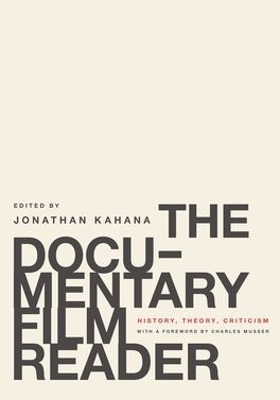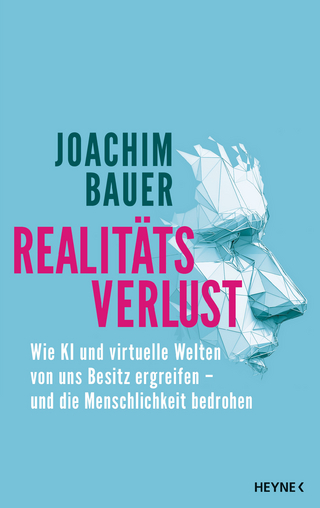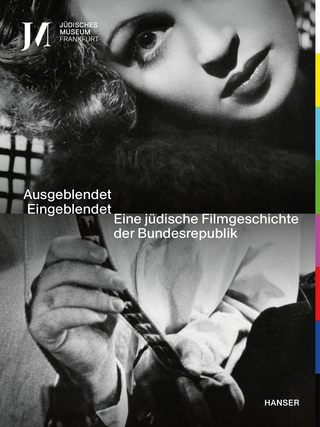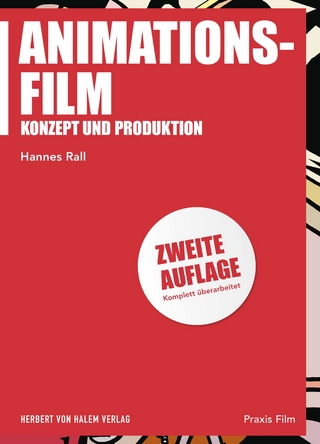
The Documentary Film Reader
Oxford University Press Inc (Verlag)
978-0-19-973964-6 (ISBN)
Jonathan Kahana is Associate Professor of Film and Digital Media at the University of Santa Cruz. He is the author of Intelligence Work: The Politics of American Documentary.
Foreword by Charles Musser ; Introduction ; I. Early Documentary: From the Illustrated Lecture to the Factual Film ; Jonathan Kahana, Introduction to Section I ; Rick Altman, "From Lecturer's Prop to Industrial Product: The Early History of Travel Films" (2006) ; Anonymous, "Burton Holmes Pleases a Large Audience at the Columbia" (1905) ; Kristen Whissel, "Placing the Spectator on the Scene of History: Modern Warfare and the Battle Reenactment at the Turn of the Century" (2008) ; Dai Vaughan, "Let There Be Lumiere" (1999) ; Boleslas Matuszewski, "A New Source of History" (1898) ; Tom Gunning, "Before Documentary: Early Nonfiction Films and the 'View' Aesthetic" (1997) ; Edward Curtis et al., "The Continental Film Company" (1912) ; W. Stephen Bush, "In The Land of the Head Hunters" (1914) ; Catherine Russell, "Playing Primitive" (1999) ; Anonymous, "Movies of Eskimo Life Win Much Appreciation" (1915) ; Anonymous, "Nanook of the North" (1922) ; John Grierson, "Flaherty's Poetic Moana" (1926) ; John Grierson, "Flaherty" (1931-32) ; Hamid Naficy, "Lured by the East: Ethnographic and Expedition Films about Nomadic Tribes; The Case of Grass" (2006) ; Bela Balazs, "Compulsive Cameramen" (1925) ; Anonymous, "New Films Make War Seem More Personal" (1916) ; Nicholas Reeves, "Cinema, Spectatorship, and Propaganda: Battle of the Somme (1916) and Its Contemporary Audience" (1997) ; II. Modernisms: State, Left, and Avant-Garde Documentary Between the Wars ; Jonathan Kahana, Introduction to Section II ; Robert Allerton Parker, "The Art of the Camera: An Experimental 'Movie'" (1921) ; Siegfried Kracauer, "Montage" (1947) ; Annette Michelson, "The Man with the Movie Camera: From Magician to Epistemologist" (1972) ; Seth Feldman, "Cinema Weekly and Cinema Truth: Dziga Vertov and the Leninist Proportion" (1973) ; Dziga Vertov, "WE: Variant of a Manifesto" (1922) ; Jay Leyda, "Bridge" (1964) ; Mikhail Iampolsky, "Reality at Second Hand" (1991) ; Joris Ivens, "The Making of Rain" (1969) ; Joris Ivens, "Reflections on the Avant-Garde Documentary" (1931) ; Tom Conley, "Documentary Surrealism: On Land Without Bread" (1986) ; John Grierson, "The Documentary Producer" (1933) ; John Grierson, "First Principles of Documentary" (1932-34) ; Otis Ferguson, "Home Truths from Abroad" (1937) ; Charles Wolfe, "Straight Shots and Crooked Plots: Social Documentary and the Avant-Garde in the 1930s" (1995) ; Samuel Brody, "The Revolutionary Film: Problem of Form" (1934) ; Leo T. Hurwitz, "The Revolutionary Film: Next Step" (1934) ; Ralph Steiner and Leo T. Hurwitz, "A New Approach to Filmmaking" (1935) ; Willard Van Dyke, Letter from Knoxville (1936) ; Ralph Steiner, Letter to Jay Leyda (1935) ; John T. McManus, "Down to Earth in Spain" (1937) ; Charles Wolfe, "Historicizing the 'Voice of God': The Place of Voice-Over Commentary in Classical Documentary" (1997) ; Steve Neale, "Triumph of the Will: Notes on Documentary and Spectacle" (1979) ; Richard Griffith, "Films at the Fair" (1939) ; III: Documentary Propaganda: World War II and the Post-War Citizen ; Jonathan Kahana, Introduction to Section III ; James Agee, Review of Iwo Jima newsreels (1945) ; James Agee, Review of San Pietro (1945) ; Thomas Cripps and David Culbert, "The Negro Soldier (1944): Film Propaganda in Black and White" (1979) ; Andre Bazin, "On Why We Fight: History, Documentation, and the Newsreel" (1946) ; Jim Leach, "The Poetics of Propaganda: Humphrey Jennings and Listen to Britain" (1998) ; George C. Stoney, "Documentary in the United States in the Immediate Post-World War II Years" (1989) ; Zoe Druick, "Documenting Citizenship: Reexamining the 1950s National Film Board Films about Citizenship" (2000) ; Srirupa Roy, "Moving Pictures: The Films Division of India and the Visual Practices of the Nation-State" (2007) ; Jennifer Horne, "Experiments in Propaganda: Reintroducing James Blue's Colombian Trilogy" (2009) ; Peter Watkins with James Blue and Michael Gill, "Peter Watkins Discusses His Suppressed Nuclear Film The War Game" (1965) ; IV. Aesthetics of Liberation: Free, Direct, and Verite Cinemas ; Jonathan Kahana, Introduction to Section IV ; Jean Painleve, "The Castration of Documentary" (1953) ; Jean Cocteau, "On Blood of the Beasts" (1963) ; Lindsay Anderson, "Free Cinema" (1957) ; Tom Whiteside, "The One-Ton Pencil" (1962) ; Edgar Morin, "Chronicle of a Film" (1962) ; Jonathan Rosenbaum, "Radical Humanism and the Coexistence of Film and Poetry in The House is Black" (2003) ; Jean Rouch with Dan Georgakas, Udayan Gupta, and Judy Janda, "The Politics of Visual Anthropology" (1977) ; Ricky Leacock, "For an Uncontrolled Cinema" (1961) ; Bruce Elder, "On the Candid-Eye Movement" (1977) ; Jonas Mekas, "To Mayor Lindsay / On Film Journalism and Newsreels" (1966) ; Jeanne Hall, "Realism as a Style in Cinema Verite: A Critical Analysis of Primary" (1991) ; Margaret Mead, "As Significant as the Invention of Drama or the Novel" (1973) ; V: Talking Back: Radical Voices and Visions After 1968 ; Jonathan Kahana, Introduction to Section V ; Robert Stam, "Hour of the Furnaces and the Two Avant Gardes" (1981) ; Juan Carlos Espinosa, Jorge Fraga, Estrella Pantin, "Toward a Definition of the Didactic Documentary: A Paper Presented to the First National Congress of Education and Culture" (1978) ; Marilyn Buck, Norm Fruchter, Robert Kramer, and Karen Ross, "Newsreel" (1969) ; Frederick Wiseman with Alan Westin, "'You Start Off With a Bromide': Conversation with Film Maker Frederick Wiseman" (1974) ; David MacDougall, "Beyond Observational Cinema" (1973/1992) ; Pauline Kael, "Beyond Pirandello" (1970) ; Pearl Bowser, "Pioneers of Black Documentary Film" (1999) ; Michael Chanan, "Rediscovering Documentary: Cultural Context and Intentionality" (1990) ; Santiago Alvarez with the editors of Cineaste, "'5 Frames Are 5 Frames, Not 6, But 5': An Interview with Santiago Alvarez" (1975) ; Abe Mark Nornes, "The Postwar Documentary Trace: Groping in the Dark" (2002) ; Emile de Antonio with Tanya Neufeld, "An Interview with Emile de Antonio" (1973) ; Annette Michelson, Reply to de Antonio (1973) ; Bill Nichols, "The Voice of Documentary" (1983) ; James Roy MacBean, "Two Laws from Australia, One White, One Black: The Recent Past and the Challenging Future of Ethnographic Film" (1983) ; Lee Atwell, Review of Word is Out (1979) ; Julia Lesage, "The Political Aesthetics of the Feminist Documentary Film" (1978) ; E. Ann Kaplan, "Theories and Strategies of the Feminist Documentary" (1983) ; Jill Godmilow, "Paying Dues: A Personal Experience with Theatrical Distribution" (1977) ; Coco Fusco, "A Black Avant-Garde? Notes on Black Audio Film Collective and Sankofa" (1988) ; Renee Tajima, Letter to Scott MacDonald (1995) ; John Greyson, "Strategic Compromises: AIDS and Alternative Video Practices" (1990) ; VI. Truth Not Guaranteed: Reflections, Revisions, and Returns ; Editor's section introduction ; Robert Sklar, "Documentary: Artifice in the Service of Truth" (1975) ; Jonas Mekas, "The Diary Film (A Lecture on Reminiscences of a Journey to Lithuania)" (1972) ; Chick Strand, "Notes on Ethnographic Film by a Film Artist" (1978) ; Michael Renov, "Toward a Poetics of Documentary" (1993) ; Trinh T. Minh-ha, "Mechanical Eye, Electronic Ear and the Lure of Authenticity" (1984) ; Brian Winston, "The Tradition of the Victim in Griersonian Documentary" (1988) ; J. Hoberman, "Shoah: The Being of Nothingness" (1985-86) ; Claude Lanzmann with Marc Chevrie and Herve Le Roux, "Site and Speech: An Interview with Claude Lanzmann about Shoah" (1985) ; Linda Williams, "Mirrors without Memories: Truth, History, and the New Documentary" (1993) ; Peter Bates, "Truth Not Guaranteed: An Interview with Errol Morris" (1989) ; Harlan Jacobson with Michael Moore, "Michael & Me" (1989) ; Thomas Waugh, "'Acting to Play Oneself': Notes on Performance in Documentary" (1990) ; Phillip Brian Harper, "Marlon Riggs: The Subjective Position of Documentary Video" (1995) ; Paula Rabinowitz, "Melodrama/Male Drama: The Sentimental Contract of American Labor Films" (2002) ; Marsha Orgeron and Devin Orgeron, "Familial Pursuits, Editorial Acts: Documentaries After the Age of Home Video" (2007) ; Vivian Sobchack, "Inscribing Ethical Space: 10 Propositions on Death, Representation, and Documentary" (1984) ; Paul Arthur, "Jargons of Authenticity (Three American Moments)" (1993) ; VII: Documentary Transformed: Transnational and Transmedial Crossings ; Jonathan Kahana, Introduction to Section VII ; Harun Farocki and Jill Godmilow with Jennifer Horne and Jonathan Kahana, "A Perfect Replica: An Interview with Harun Farocki and Jill Godmilow" (1998) ; Rachel Gabara, "Mixing Impossible Genres: David Achkar and African Autobiographical Documentary" (2003/2013) ; Jean-Marie Teno, "Writing on Walls: The Future of African Documentary Cinema" (2010) ; Chris Berry, "Getting Real: Chinese Documentary, Chinese Postsocialism" (2007) ; Wu Wenguang, "DV: Individual Filmmaking" (2006) ; Richard Porton, "Weapon of Mass Instruction: Michael Moore's Fahrenheit 9/11" (2004) ; Scott MacDonald, "Up Close and Political: Three Short Ruminations on Ideology in the Nature Film" (2006) ; Amy Villarejo, "Bus 174 and the Living Present" (2006) ; Barbara Klinger, "Cave of Forgotten Dreams: Meditations on 3D" (2012) ; Index
| Zusatzinfo | 91 halftones |
|---|---|
| Verlagsort | New York |
| Sprache | englisch |
| Maße | 267 x 187 mm |
| Gewicht | 2010 g |
| Themenwelt | Kunst / Musik / Theater ► Film / TV |
| Sozialwissenschaften ► Kommunikation / Medien ► Medienwissenschaft | |
| ISBN-10 | 0-19-973964-1 / 0199739641 |
| ISBN-13 | 978-0-19-973964-6 / 9780199739646 |
| Zustand | Neuware |
| Haben Sie eine Frage zum Produkt? |
aus dem Bereich


